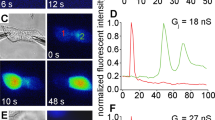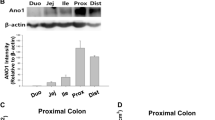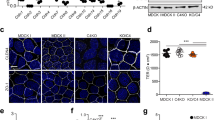Abstract
In ‘leaky‘ epithelia, ions move through both a transcellular and a paracellular (serial alignment of tight junction and intercellular space) path. The efficiency of transepithelial transport could therefore be regulated if the cell was able to alter reversibly the permeability of tight junctions. (These are specialized regions of the apical cell membranes common to all epithelia.) We now report that such a mechanism indeed exists in the Necturus gallbladder. It is effected by cyclic AMP, which is already known to mediate surface membrane phenomena in a variety of cell systems through its interaction with the cytoskeletal system1,2. In gallbladders mounted and perfused with electrolyte solutions in an Ussing-type chamber, exposure of the mucosal surface to cyclic AMP analogues increased transepithelial electrical resistance, potential difference and short-circuit current and decreased NaCl dilution potentials in a rapid and reversible manner. We also observed rapid depolarization of cell membrane electrical potentials and a slow decline in intracellular K+ activity. Freeze-fracture electron microscopy of tissues fixed with glutaraldehyde during the peak electrical response showed a reorientation of intramembranous junctional fibrils, suggesting that cyclic AMP reduces the ionic permeability of the paracellular pathway in this epithelium by altering the structure of tight junctions.
This is a preview of subscription content, access via your institution
Access options
Subscribe to this journal
Receive 51 print issues and online access
$199.00 per year
only $3.90 per issue
Buy this article
- Purchase on Springer Link
- Instant access to full article PDF
Prices may be subject to local taxes which are calculated during checkout
Similar content being viewed by others
References
Willingham, M. C. & Pastan, I. Proc. natn. Acad. Sci. U.S.A. 72, 1263–1267 (1975).
Harmanci, M. C., Kachadorian, W. A., Valtin, H. & DiScala, V. A. Am. J. Physiol. 235, F440–F443 (1978).
Reuss, L. & Finn, A. L. J. Membrane Biol. 25, 115–139 (1975).
Graf, J. & Giebisch, G. J. Membrane Biol. 47, 327–355 (1979).
Reuss, L. J. Membrane Biol. 41, 65–86 (1978).
Frömter, E. J. Membrane Biol. 8, 259–301 (1972).
Bentzel, C. J. et al. Am. J. Physiol. 239, C75–C89 (1980).
Jacobson, H. R. Am. J. Physiol. 236, F71–F79 (1979).
Powell, D. W., Farris, R. K. & Carbonetto, S. T. Am. J. Physiol. 227, 1428–1435 (1974).
Schultz, S. G., Frizzell, R. A. & Nellans, H. N. J. Membrane Biol. 33, 351–384 (1977).
Duffey, M. E., Turnheim, K., Frizzell, R. A. & Schultz, S. G. J. Membrane Biol. 42, 229–245 (1978).
Author information
Authors and Affiliations
Rights and permissions
About this article
Cite this article
Duffey, M., Hainau, B., Ho, S. et al. Regulation of epithelial tight junction permeability by cyclic AMP. Nature 294, 451–453 (1981). https://doi.org/10.1038/294451a0
Received:
Accepted:
Issue Date:
DOI: https://doi.org/10.1038/294451a0
This article is cited by
-
Breaking Down Barriers: How Understanding Celiac Disease Pathogenesis Informed the Development of Novel Treatments
Digestive Diseases and Sciences (2019)
-
Long-Acting β2-Agonists
American Journal of Respiratory Medicine (2002)
-
Enhancement of paracellular transport of heparin disaccharide across Caco-2 cell monolayers
Archives of Pharmacal Research (2002)
Comments
By submitting a comment you agree to abide by our Terms and Community Guidelines. If you find something abusive or that does not comply with our terms or guidelines please flag it as inappropriate.



